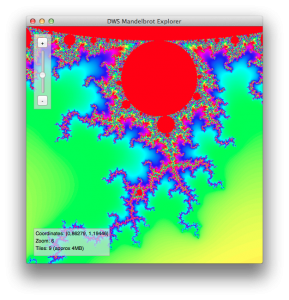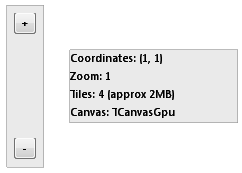Everything you need to know about FireMonkey canvases – and a performance boost bugfix for some people as well!
I recently posted my first real-world FireMonkey app, which gave a zoomable, scrollable, very interactive view of the Mandelbrot fractal using the precomputed DWS Mandelbrot tiles. It worked fine on my computer.
Contents
What’s in this article?
- The role of canvases in FireMonkey rendering
- Overview of each possible Windows canvas class: GDI+, Direct2D, and GPU
- How does FireMonkey choose which canvas class to use?
- Investigating when Direct2D is chosen vs GDI+, and we find a bug
- Fixing the bug – three possible solutions
- For testing: how to force the selection of a specific class
- Checking what class you are using
- Summary
The role of canvases in FireMonkey rendering
- TCanvasGDIPlus (Windows)
- TCanvasD2D (Windows)
- TCanvasGpu (Windows)
- TCanvasQuartz (OSX)
- TCanvasQuartz (iOS, implementation appears independent of the OSX class with the same name)
- At least one more for Android in XE5+.
Each Windows canvas class
GDI+
TCanvasGDIPlus is the default, fallback canvas. It uses GDI+, a software-only, fairly slow, API provided by Microsoft in the Windows XP days. It will run on anything, but your rendering performance may not be great. For example, in my fractal app which draws anywhere from four to a few dozen 256×256 tiles at various scales on the window with every paint, at the default small window size click-dragging to navigate is fast. But if you maximise the window, and the rendering area becomes much larger, scrolling around – which invalidates with every mouse movement, effectively drawing as fast as possible – is painfully laggy. This is not FireMonkey’s fault. It is one of the problems with using GDI+, and I have experienced the same problem drawing complex interactive UIs with GDI+ before.
If your app is rendering using this class – I show how to find out which class later – I strongly recommend you find out why and do what you can to fix it. In general, avoid using this class if possible.
You will always end up using the class on Windows XP, since it’s the only one supported. On all other versions of Windows, Vista and above, 99% of the time you will be able to use TCanvas2D instead (once you fix a problem with when it’s chosen) and I highly recommend you do this.
Direct2D
TCanvasD2D uses Direct2D, a 2D API implemented over Direct3D, which is available on Vista SP2+ and above. It is hardware-accelerated and fast, and theoretically the default. The quick answer is that you want to use this class if at all possible, but you may need to make some code changes to do it. Without some very small tweaks, there are cases where FireMonkey will choose a GDI+ canvas instead of a D2D one on hardware where D2D would run faster – much, much faster. This is rare, but my setup is one where it occurs.
GPU
TCanvasGpu is turned off by default, and is only used if the global FMX.Types.GlobalUseGPUCanvas is true. (Set this in your project file before Application.Initialize.) It’s quite neat in that it uses a base class TContext3D to do its work, which has a very similar system for choosing which subclass is appropriate to instantiate as the canvas system. There are context classes for D3D9, D3D10, GLES and Quartz.
The first time I tried this out, it crashed immediately – FillText ends up calling TCharHelper.ConvertToUtf32 with an empty string, which raises an exception. Reading the preceding code, which seems to implement text wrapping, I don’t understand why it’s trying to do what it is.
On my machine, it uses a TDX9Context to draw. There are noticeable severe rendering bugs. In my fractal app one control, a TTrackBar, doesn’t draw at all. Text draws ‘bold’, which looks similar to the effect you get drawing antialiased text over itself many times. Buttons had one-pixel-wide edges missing.
I don’t know how much of this is due to the TDX9Context it was using, and how much is due to TCanvasGPU itself. Since on DX10-class hardware FireMonkey will use Direct2D, DirectX-9 class hardware is the only use case on Windows for this class. (As it turns out, we should normally use Direct2D even for DirectX9 hardware. More information below.) The severity of the bugs are, I suspect, why it is turned off by default. I do not recommend manually turning it on.
How does FireMonkey choose which canvas class to use?
Investigating when Direct2D is chosen over GDI+, and a FMX bugfix
First off, the easy case: GDI+ is the fallback, and is always available on machines that meet the FireMonkey requirements. It is always registered. This means that if the Direct2D class is not registered, your app will end up using GDI+.
Direct2D is trickier. And remember, any bug or quirk here that invalidly thinks D2D is not the right choice will cause the GDI+ canvas to be chosen instead, and that’s bad.
Fmx.Canvas.D2D.pas‘s RegisterCanvasClasses method checks the Direct3D 10 capabilities reported by DirectX, and registers the D2D canvas if the D3D10 driver type is either hardware or WARP. This latter is interesting: the Windows Advanced Rasterization Platform is a software rasterizer supporting Direct3D 9.1 through 10.1 feature levels, and by all accounts is a very good one. It is part of the DX11 runtime which you need to have installed, which is part of the platform update for Vista or Windows 7. You should already have these automatically through Windows Update.
Direct2D applications benefit from hardware-accelerated rendering on modern mainstream GPUs. Hardware acceleration is also achieved on earlier Direct3D 9 hardware by using Direct3D 10-level-9 rendering. This combination provides excellent performance on graphics hardware on existing Windows PCs.
…
When rendering in software, applications that use Direct2D experience substantially better rendering performance than with GDI+ and with similar visual quality.
In other words, on DirectX 9.1 hardware there is a high-performance hardware rasterizer available and on lesser hardware there is still a high-performance software rasterizer available. Now, for DirectX 10 and above, it’s simple: Direct2D will be chosen. But for DirectX9-class hardware, there is a choice between two software renderers: GDI+, an old and slow API, or WARP, a speedy, very technically impressive API. Clearly, where possible, FireMonkey should choose to use it, falling back to GDI+ only if nothing else whatsoever is possible. As you’ve no doubt guessed if you’ve read this far, it doesn’t, and this is what we need to investigate and fix.
The problem lies in TCustomDX10Context.CheckDevice. An edited version of the problematic portion of code is:
1 2 3 4 5 6 7 8 9 10 | if ...{can create a D3D hardware device} then begin FDriverType := D3D10_DRIVER_TYPE_HARDWARE; end else if not TCustomDX9Context.HardwareSupported and Succeeded(D3D10CreateDevice1Ex(D3D10_DRIVER_TYPE_WARP, D3D10_CREATE_DEVICE_BGRA_SUPPORT, g_pd3dDevice)) then begin // Switch to software mode FDriverType := D3D10_DRIVER_TYPE_WARP; end; |
It’s this else statement that is problematic. It basically says to use WARP if it’s supported (fine) but only if Direct3D9-class hardware is not supported (not fine.) Almost all computers since about 2005 will support D3D9, and this API is available on Vista and above. The only reason I can think of for this is that TCanvasGpu with D3D9 support is expected to be the fallback here before GDI+. However, as we’ve seen, not only is that class buggy but it is disabled by default (probably because it’s buggy.) This means that anyone with D3D9 hardware (but not D3D10+ hardware), and that includes people running on virtual machines like VMWare Fusion, which only supports D3D9 emulation, will end up using GDI+ when they could be using the much faster WARP.
How can we fix it?
A global switch
Normally the best way to force FireMonkey to choose a particular graphics path is via one of the globals at the top of FMX.Types.pas. There is a potentially suitable one: GlobalUseDX10Software. (Remember you need to set these in your project file before you call Application.Initialize.) It’s false by default but if you set it to true, you will get WARP. Unfortunately, this means you will always get WARP when possible, even when hardware DX10 support is available. No matter how good WARP is we should choose the hardware-accelerated option when possible, and so this is a no go.
Edit the FireMonkey source
The second option is to edit the FMX source. To do this, make a local copy of FMX.Context.DX10.pas in your program’s source folder. (I do not recommend editing RTL source directly and trying to recompile FMX – leave it alone and make your changes separately. If you add your local file to the project it will be used in preference to the RTL version. Just make sure you document what you’ve changed for future you.)
Add this local file to your project, and remove the ‘not‘ from the else if statement above. It should look something like this:
1 | end else if {not TCustomDX9Context.HardwareSupported and} ... |
Recompile and you should get a Direct2D canvas. If you were using the GDI+ canvas before, you should notice a significant difference.
Manual code
The final – and probably best – option is to add some code to try to create a D3D10 context and check the driver type, and if it returns WARP then turn on the above switch. The following slightly ugly method (it’s 1AM…) does the trick; call it before Application.Initialize in the project file. This method depends on FMX.Types, Winapi.D3D10_1, Winapi.D3D10, and WinAPI.Windows.
Because of the method’s dependencies and for code cleanliness, I would suggest putting this in a separate unit from the main project source, and ifdef both the unit being included, and the method being called, out completely if you are not compiling for Windows (the MSWINDOWS constant.) As suggested by a commenter below, it is probably also a good idea to ifdef for your specific Delphi version in case this is fixed in future.
The below code doesn’t check for D3D9 hardware support, assuming that if it can create a WARP device that’s enough. Feel free to add back in additional checks.
1 2 3 4 5 6 7 8 9 10 11 12 13 14 15 16 17 18 19 20 21 22 23 24 25 26 27 28 | procedure TryUseWARPCanvas; var DX10Library : THandle; TestDevice : ID3D10Device1; begin DX10Library := LoadLibrary(Winapi.D3D10_1.D3D10_1_dll); if DX10Library = 0 then Exit; try SaveClearFPUState; // Copy from FMX.Context.DX10 try if GetProcAddress(DX10Library, ‘D3D10CreateDevice1’) = nil then Exit; // If there’s no hardware D3D10 support, but there /is/ WARP (software support) // force that to be used. Don’t bother checking DX9 support, just go for WARP. if not Succeeded(D3D10CreateDevice1(nil, D3D10_DRIVER_TYPE_HARDWARE, 0, D3D10_CREATE_DEVICE_BGRA_SUPPORT, D3D10_FEATURE_LEVEL_10_1, D3D10_1_SDK_VERSION, TestDevice)) and Succeeded(D3D10CreateDevice1(nil, D3D10_DRIVER_TYPE_WARP, 0, D3D10_CREATE_DEVICE_BGRA_SUPPORT, D3D10_FEATURE_LEVEL_10_1, D3D10_1_SDK_VERSION, TestDevice)) then begin FMX.Types.GlobalUseDX10Software := true; end; finally TestDevice := nil; RestoreFPUState; // Copy from FMX.Context.DX10 end; finally FreeLibrary(DX10Library); end; end; |
Tweaks to this code
You might want to change a few things about this code:
- Editing the FMX code: to match the manual code, I changed it to remove the DX9 check entirely. It either sees if it can create a D3D10 hardware device, or otherwise tries to create a WARP device. Thanks Remy for the suggestion.
- Untested useful tweak: Direct2D is still hardware-accelerated on DX9-class hardware. Try changing the feature level to D3D10_FEATURE_LEVEL_9_1 to see if it has this level hardware support on your computer. You will need to change both the manual code test (if you use it) and the FireMonkey code creating the devices in the same area as above to match. I haven’t tested this and it’s just an idea for further investigation; the current code goes either either with D3D10-hardware or WARP, which I know for sure will work and are good, safe modifications to make. Changing this will always require editing the FMX source.
- XP support: with Microsoft dropping XP support on April 8, 2014, it’s quite possible the next version of Delphi will not need to support XP at all – or at least, will only do so as a legacy option. I would suggest that Embarcadero make some changes requiring the Platform Update be installed as prerequisite for FireMonkey apps, and then using one of the D3D10, D3D9-feature-level, or software WARP Direct2D canvases as the only option on Vista and above, and only using GDI+ on XP. There should never be a case on Vista or Windows 7 where GDI+ is the chosen canvas.
For testing: how to force the selection of a specific class
I stated at the beginning that you should test with each possible canvas type, in order to catch code tht works with one and doesn’t with another. How?
- To force GDI+, set FMX.Types.GlobalUseDirect2D to false.
- To force Direct2D (using the WARP software rasterizer even with hardware support – so only for testing) set FMX.Types.GlobalUseDX10Software to true.
- To force the GPU canvas (unnecessary for testing, since it’s off by default) set FMX.Types.GlobalUseGPUCanvas to true.
How to check what class you are actually using
Summary
- FireMonkey has several underlying graphics classes depending on the platform and, on Windows, on the capabilities of the platform
- You need to test each one, because code that works on one can fail on another
- On Windows, if you (or a user) have D3D9 hardware (but not D3D10 or higher hardware) FireMonkey will use GDI+ to render where it probably shouldn’t, which will make your program noticeably slower when run on (a) D3D9-class hardware, or (b) in a virtual machine like VMWare Fusion. It should use Direct2D’s software rasterizer instead. Fix this with one of the three ways above; I recommend with the sample code I showed above.


